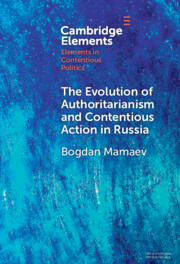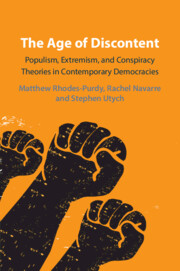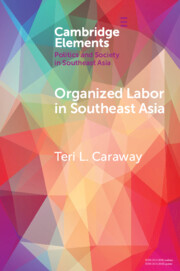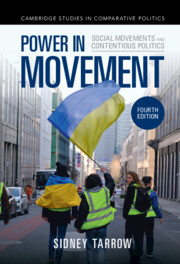Refine search
Actions for selected content:
74 results
10 - New Resistance to Clearcutting in Finland
- from Part IV - Pulping Finland
-
- Book:
- Clearcut
- Published online:
- 03 October 2025
- Print publication:
- 02 October 2025, pp 220-238
-
- Chapter
-
- You have access
- Open access
- HTML
- Export citation
Contentious Places: Rome’s Transcripts of Lived Space and Popular Resistance
-
- Journal:
- Antichthon , First View
- Published online by Cambridge University Press:
- 16 September 2025, pp. 1-23
-
- Article
- Export citation
9 - Post-Communist Democracy, Civil Society, and the Problem of Accountability
- from Part II - Civil Society, Social Media, and Political Messaging
-
-
- Book:
- Global Challenges to Democracy
- Published online:
- 01 May 2025
- Print publication:
- 15 May 2025, pp 176-195
-
- Chapter
- Export citation
1 - Introduction
-
- Book:
- Invisible Revolutionaries
- Published online:
- 17 April 2025
- Print publication:
- 24 April 2025, pp 1-38
-
- Chapter
- Export citation
The Hong Kong-Taiwan Nexus in the Shadow of China
-
- Journal:
- Asia-Pacific Journal / Volume 20 / Issue 16 / September 2022
- Published online by Cambridge University Press:
- 14 March 2025, e7
-
- Article
-
- You have access
- Open access
- Export citation
Does Hard Propaganda (Also) Work in Democracies? Evidence from the United States
-
- Journal:
- Perspectives on Politics , First View
- Published online by Cambridge University Press:
- 03 March 2025, pp. 1-18
-
- Article
-
- You have access
- Open access
- HTML
- Export citation

The Evolution of Authoritarianism and Contentious Action in Russia
-
- Published online:
- 30 May 2024
- Print publication:
- 20 June 2024
-
- Element
- Export citation
Is terrorism necessarily violent? Public perceptions of nonviolence and terrorism in conflict settings
-
- Journal:
- Political Science Research and Methods / Volume 12 / Issue 3 / July 2024
- Published online by Cambridge University Press:
- 22 June 2023, pp. 521-539
-
- Article
-
- You have access
- Open access
- HTML
- Export citation
4 - How Contestation Shapes Access to Judicial Remedy Mechanisms
-
- Book:
- Seeking Justice
- Published online:
- 09 June 2023
- Print publication:
- 15 June 2023, pp 68-109
-
- Chapter
- Export citation
5 - How Contestation Shapes Access to Non-Judicial Remedy Mechanisms
-
- Book:
- Seeking Justice
- Published online:
- 09 June 2023
- Print publication:
- 15 June 2023, pp 110-142
-
- Chapter
- Export citation
7 - Corruption, Populism, and Contentious Politics in Brazil and Chile
-
- Book:
- The Age of Discontent
- Published online:
- 02 March 2023
- Print publication:
- 09 March 2023, pp 154-179
-
- Chapter
- Export citation

The Age of Discontent
- Populism, Extremism, and Conspiracy Theories in Contemporary Democracies
-
- Published online:
- 02 March 2023
- Print publication:
- 09 March 2023

Organized Labor in Southeast Asia
-
- Published online:
- 31 January 2023
- Print publication:
- 23 February 2023
-
- Element
- Export citation
Equivocal Challenges: Tactical Ambiguity and Deferral of Claim-Making in the 1948 Bogotazo
-
- Journal:
- Social Science History / Volume 47 / Issue 1 / Spring 2023
- Published online by Cambridge University Press:
- 27 January 2023, pp. 67-94
- Print publication:
- Spring 2023
-
- Article
- Export citation
4 - Regime Change (Maidan)
-
- Book:
- Ukraine's Unnamed War
- Published online:
- 15 January 2023
- Print publication:
- 05 January 2023, pp 67-99
-
- Chapter
- Export citation
Introduction
-
- Book:
- Sunni City
- Published online:
- 10 November 2022
- Print publication:
- 24 November 2022, pp 1-27
-
- Chapter
- Export citation
5 - The Future Movement
-
- Book:
- Sunni City
- Published online:
- 10 November 2022
- Print publication:
- 24 November 2022, pp 140-174
-
- Chapter
- Export citation
Peaceful Wars and Unlikely Unions: The Azhar Strike of 1909 and the Politics of Comparison in Egypt
-
- Journal:
- Comparative Studies in Society and History / Volume 65 / Issue 1 / January 2023
- Published online by Cambridge University Press:
- 09 November 2022, pp. 141-166
-
- Article
-
- You have access
- Open access
- HTML
- Export citation
“Single Sparks” and Legacies: An Eventful Account of the May Fourth Movement
-
- Journal:
- The China Quarterly / Volume 253 / March 2023
- Published online by Cambridge University Press:
- 12 September 2022, pp. 1-18
- Print publication:
- March 2023
-
- Article
- Export citation

Power in Movement
- Social Movements and Contentious Politics
-
- Published online:
- 25 August 2022
- Print publication:
- 11 August 2022
-
- Textbook
- Export citation
